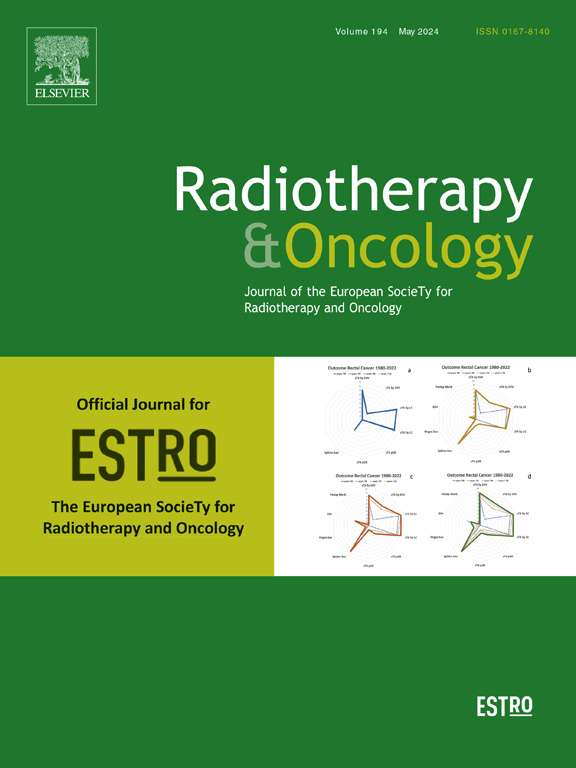局限性疾病小细胞肺癌(NIELS)患者不均匀剂量递增放疗北欧试验的设计和试验前剂量计划质量保证
IF 4.9
1区 医学
Q1 ONCOLOGY
引用次数: 0
摘要
背景和目的:NIELS试验将检查对于有限疾病小细胞肺癌患者,不均匀剂量递增放射治疗是否可以提高总生存率,平均剂量为80 Gy,分40次(fx),每日两次(BID)。由于剂量递增的固有风险,试验前质量保证尤为重要。本研究旨在探讨NIELS试验计划方法在多中心环境下的可行性。材料和方法:NIELS试验将在标准剂量放疗(60 Gy/40fx BID)和不均匀剂量递增放疗(高达80 Gy/40fx BID)之间随机分配患者。5例有代表性的患者病例被分配到7个北欧中心,用于标准剂量和递增剂量计划的试验前质量保证计划。升级的目标是原发肿瘤(GTVp)和受累淋巴结(GTVn)。我们评估了可实现剂量递增和危及器官剂量(OAR)的中心间差异。结果:GTVp和GTVn的中位平均剂量分别为79.6 Gy[76.9-81.0]和75.8 Gy[68.3-81.1],所有靶标均可在标准剂量之外递增。有些目标由于桨接近而不能完全升级。在35个递增剂量计划中观察到三次单独违反强制性OAR限制。标准计划和升级计划之间的平均肺剂量有统计学差异,尽管临床较小,患者间中位差异为0.3 Gy。对心脏和食道的平均剂量没有差异。结论:NIELS试验计划的非均匀剂量递增是可行的,并且在多中心环境下,可以在遵守OAR约束的情况下进行剂量递增。本文章由计算机程序翻译,如有差异,请以英文原文为准。
Design and pre-trial dose planning quality assurance of the Nordic trial of inhomogeneous dose escalated radiotherapy for patients with limited disease small cell lung cancer: NIELS
Background and purpose
The NIELS trial will examine if inhomogeneous dose-escalated radiotherapy up to a mean dose of 80 Gy in 40 fractions (fx), twice-daily delivered (BID), for patients with limited disease small cell lung cancer can improve overall survival. Because of the inherent risks of dose-escalation, pre-trial QA is particularly important. This study aims to examine the feasibility of the NIELS trial planning approach in a multicenter setting.
Materials and methods
The NIELS trial will randomize patients between standard dose radiotherapy (60 Gy/40fx BID) and inhomogeneous dose-escalated radiotherapy (up to 80 Gy/40fx BID). Five representative patient cases were distributed to seven Nordic centers for pre-trial QA planning of a standard and an escalated dose plan. Targets for escalation were primary tumor (GTVp) and involved lymph nodes (GTVn). We evaluated inter-center variation in achievable dose-escalation and doses to organs at risk (OAR).
Results
All targets could be escalated beyond the standard dose, with a median mean dose of 79.6 Gy [76.9–81.0] and 75.8 Gy [68.3–81.1] for GTVp and GTVn. Some targets could not be fully escalated due to OAR proximity. Three separate breaches of mandatory OAR constraints were observed in 35 escalated dose plans. There was a statistical difference in mean lung dose between standard and escalated plans, though clinically small, with a median inter-patient difference of 0.3 Gy. There were no differences in mean doses to the heart and esophagus.
Conclusion
Inhomogeneous dose-escalation as planned in the NIELS trial is feasible, and the dose-escalation can be performed respecting the OAR constraints in a multi-center setting.
求助全文
通过发布文献求助,成功后即可免费获取论文全文。
去求助
来源期刊

Radiotherapy and Oncology
医学-核医学
CiteScore
10.30
自引率
10.50%
发文量
2445
审稿时长
45 days
期刊介绍:
Radiotherapy and Oncology publishes papers describing original research as well as review articles. It covers areas of interest relating to radiation oncology. This includes: clinical radiotherapy, combined modality treatment, translational studies, epidemiological outcomes, imaging, dosimetry, and radiation therapy planning, experimental work in radiobiology, chemobiology, hyperthermia and tumour biology, as well as data science in radiation oncology and physics aspects relevant to oncology.Papers on more general aspects of interest to the radiation oncologist including chemotherapy, surgery and immunology are also published.
 求助内容:
求助内容: 应助结果提醒方式:
应助结果提醒方式:


